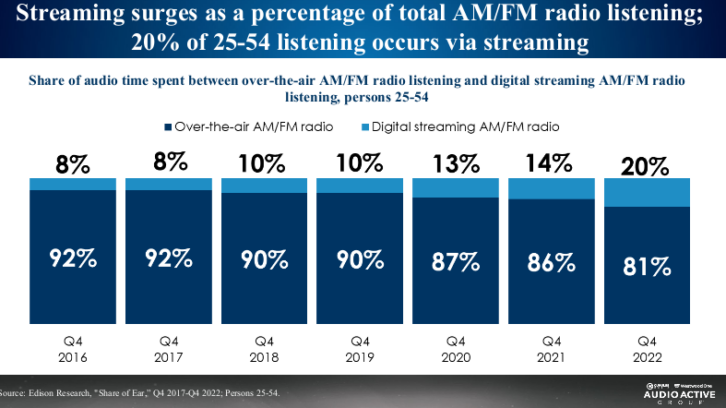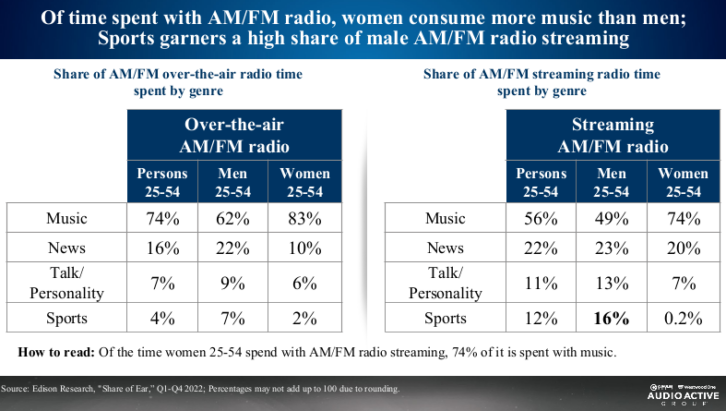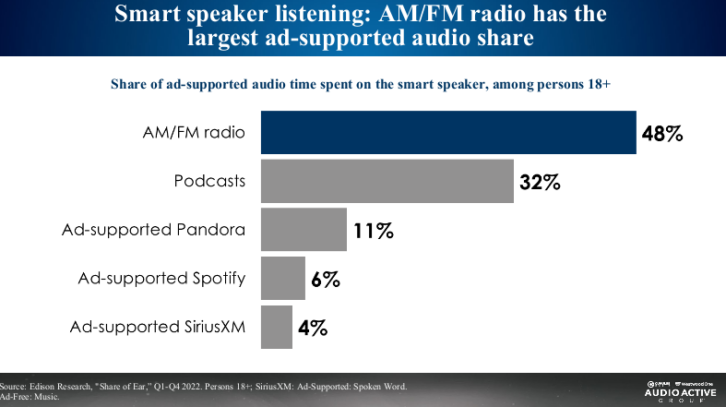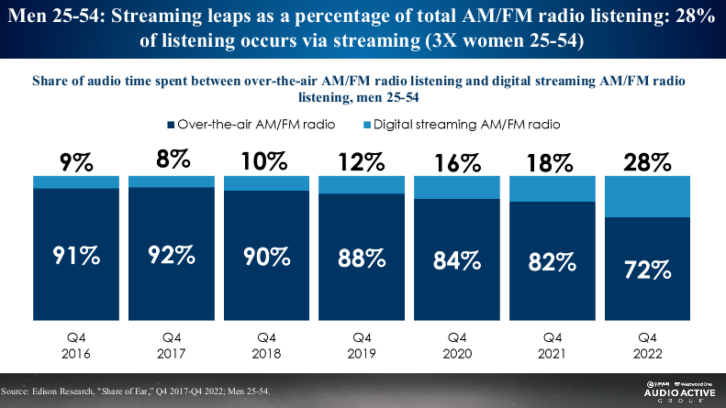Pierre Bouvard is chief insights officer at Cumulus Media and Westwood One. His job is to develop media and marketing insights to support the company’s media sellers and work with brands and agencies on their ad strategies.

He spoke with Radio World for our recently released free ebook “The Ecosystem of Streaming.” He began our interview exploring data about radio streaming from the Edison Research “Share of Ear” project. Each quarter, Edison surveys 1,000 Americans 13+ on their consumption of audio. Respondents keep a 24-hour diary to record audio use. Each published study reflects 4,000 respondents, representing a one-year rolling average.
Radio World: What are we looking at in the first slide?
Pierre Bouvard: This shows the percentage of AM/FM radio listening, how it’s split between terrestrial over-the-air in dark blue and streaming in light blue.

During the pandemic, streaming minutes were consistent with prior years but terrestrial minutes dropped because commuting went down, with people working from home. So in 2020 and 2021, although the share going to streaming went up, it was because minutes spent with terrestrial went down.
Something altogether different started happening last year: We saw legitimate increases in minutes spent with the AM/FM stream. For American adults 25 to 54, 20% of all minutes spent with AM/FM radio now is occurring through the stream. That’s double from the end of the last decade. That’s pretty substantial.
For years, streaming was just a very small percentage of radio listening. Now it is definitely growing. It’s surprising to agencies to learn that the AM/FM streaming audience is 44% bigger than Pandora’s and Spotify’s ad-supported audiences combined. If you’re enamored with streaming as an advertiser and the first words out of your mouth are Pandora and Spotify, you’re forgetting that the big kahuna in streaming is AM/FM radio.
But as the next slide shows, it is a tale of two cities, or rather a difference between men and women.
For men it’s stunning — 28% of 25–54 male listening is streaming, while for women (not shown) the percentages really have not changed in the last five or six years, hovering at 10% of listening.
Let’s dig further. On the right side of the slide below is the type of content that men are listening to.

Two things pop out here. One is Talk/Personality — it’s much higher than with women — and then look at sports for men, compared to women and their zero-point-two percent.
So spoken word content is what’s driving growth in listening to radio streams for men. And in both streaming and over-the-air AM/FM radio, men spend more time with spoken word content than women.
We’ve learned also that smart speaker listening is important. In their “Infinite Dial” study every other year, Edison asks the question, “Do you have a radio in your house?” The number has been dropping and dropping. But look at the next slide, which shows ad-supported radio.

The point is that if you’re in a house that doesn’t have radio, the smart speaker is your best friend. Since 2017 radio has done an amazing job of promoting how to listen on a smart speaker. So hats off to us as an industry. But we’ve got to keep doing it, because there are still a lot of listeners who would be astonished if you said to them, “Do you know that you have a smart speaker and you could listen to radio stations on it?”
RW: What conclusion should a manager take from these data points?
Bouvard: You have to treat streaming like a real radio station.
Consider the list of questions that you ask yourself about your over-the-air broadcast: Does it sound clear? Are the commercials well inserted? Are the commercials well separated, meaning you’re not going to hear a GEICO spot every break? Is the sound at a consistent level? When you’re inserting extra songs, how is that transition?
Back when streaming was 8% of listening, some stations may not have gone through that quality checklist. Now you have to treat streaming as seriously as if it was another FM stick — especially if you’re a station targeting males and a third of your listening is to the stream.
RW: What do you think about the quality of streaming that you hear across the industry?
Bouvard: Here’s something interesting. Historically, when the numbers were small, the feeling in the industry was to report the station separately — so in a PPM market, you’d put an encoder on the stream, put an encoder on the over-the-air signal and report them separately because maybe you could make a little bit more money with different advertisers on the stream.
But in 2020, Nielsen implemented a methodology enhancement called the headphone adjustment. It recognized that there is a fair amount of stream listening that occurs via earbuds or earphones and is not captured by the PPM. It quantified this by demographic, by format, and how much listening wasn’t being captured; and they instituted upward adjustments to streaming listening.
On average, the typical streaming audience grew 60% when this was implemented. Programmers and sales managers suddenly were looking at their streaming numbers and PPM and seeing them growing sizably. Some sports stations learned that a third, 40%, 50% of their audience listened on the stream. Especially for spoken word stations, the numbers were no longer trivial.
That introduced a new mindset: “We used to report these things separately but what if we bring them back together?” There has been a movement over the last couple of years to what’s called total line reporting, a simulcast, so stations can get a nice big number in the Nielsen.
This is a long way of answering your question, but when with a literal simulcast you don’t have uncomfortable segues or different ads or songs being inserted. In some respects, the unification of the stream and the terrestrial has increased quality because programmers are programming one station that just happens to be distributed across two platforms.
RW: What other factors are at play in the digital audio marketplace?
Bouvard: There’s a general sense that digital audio — podcasting and streaming — is really growing, especially with national marketers. Podcasting is on fire; about half of that is from direct response advertisers who will tell you they’ve never seen anything like podcasting to sell products and services. The other half are regular national advertisers.
The CPMs in podcasting are four times the CPMs of regular radio. Four! Why? Because it works so well. And it’s a low-commercial environment where, in the typical hour, you might only have four or five minutes of ads.
The “Share of Ear” reports show that the growth of streaming came at the expense of owned music, not really radio. What’s causing the erosion of share for terrestrial radio now, I believe, is podcasting. The shares from Pandora and Spotify over the last six years are basically flat to down while the shares for podcasts have gone like this [gestures sharply upwards]. If we’re losing audience, it’s not to the streamers, it’s to podcasting.
Podcasting for the most part is a national medium right now, like network TV, but that’s changing. For some people who want to listen to a particular radio show, podcasting is a godsend because it allows time shifting; and for local radio, that’s a growth opportunity.
If you want a glimpse into the future, look no further than Southern Cross Austereo in Australia, which has national shows in the biggest markets. Their talent first record the podcast, then they take segments of it to use on the over-the-air radio show. They release the podcast first rather than the other way around because those listeners are super-engaged.
Read more about trends in streaming for radio in Radio World’s ebook.











